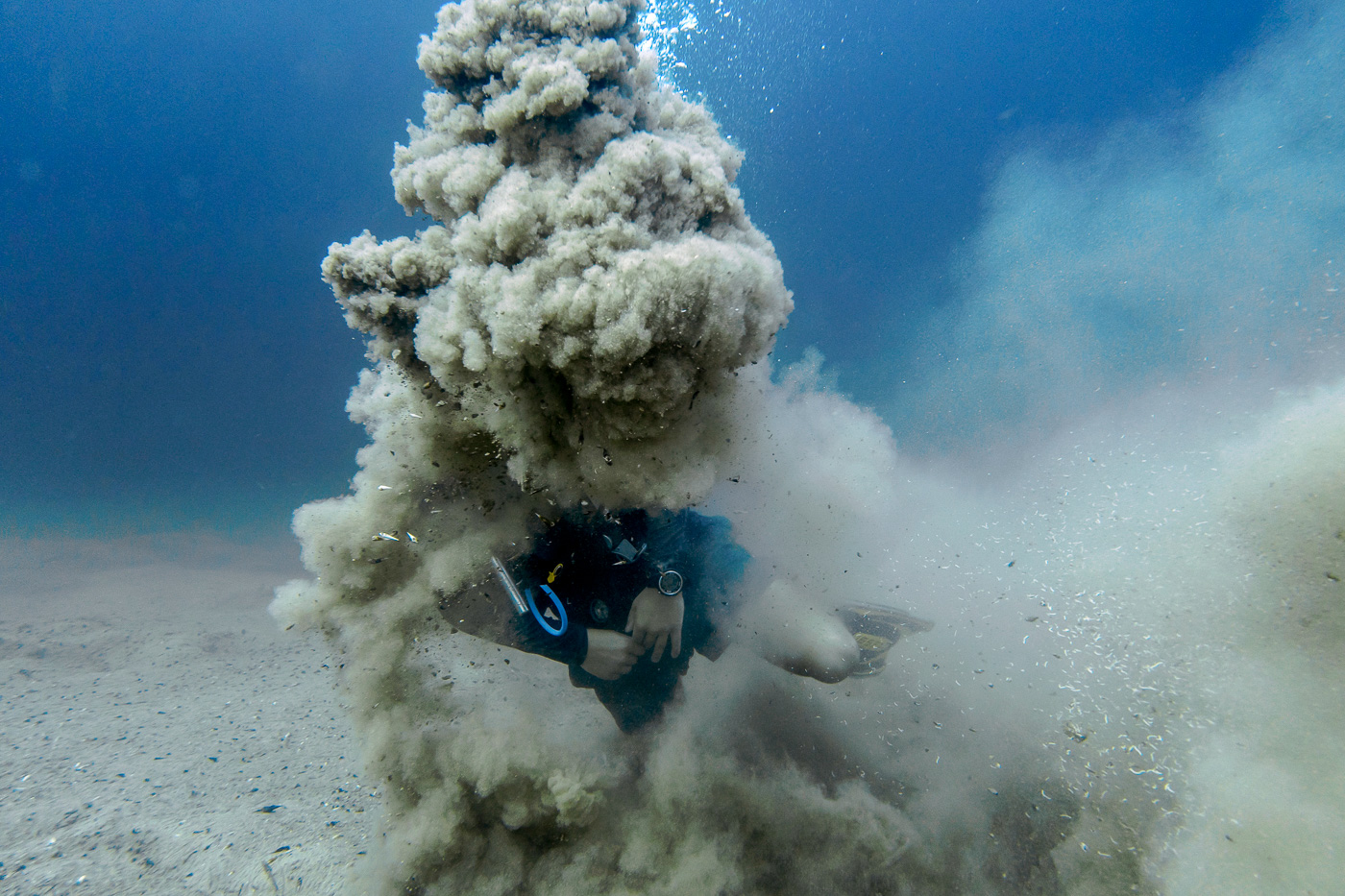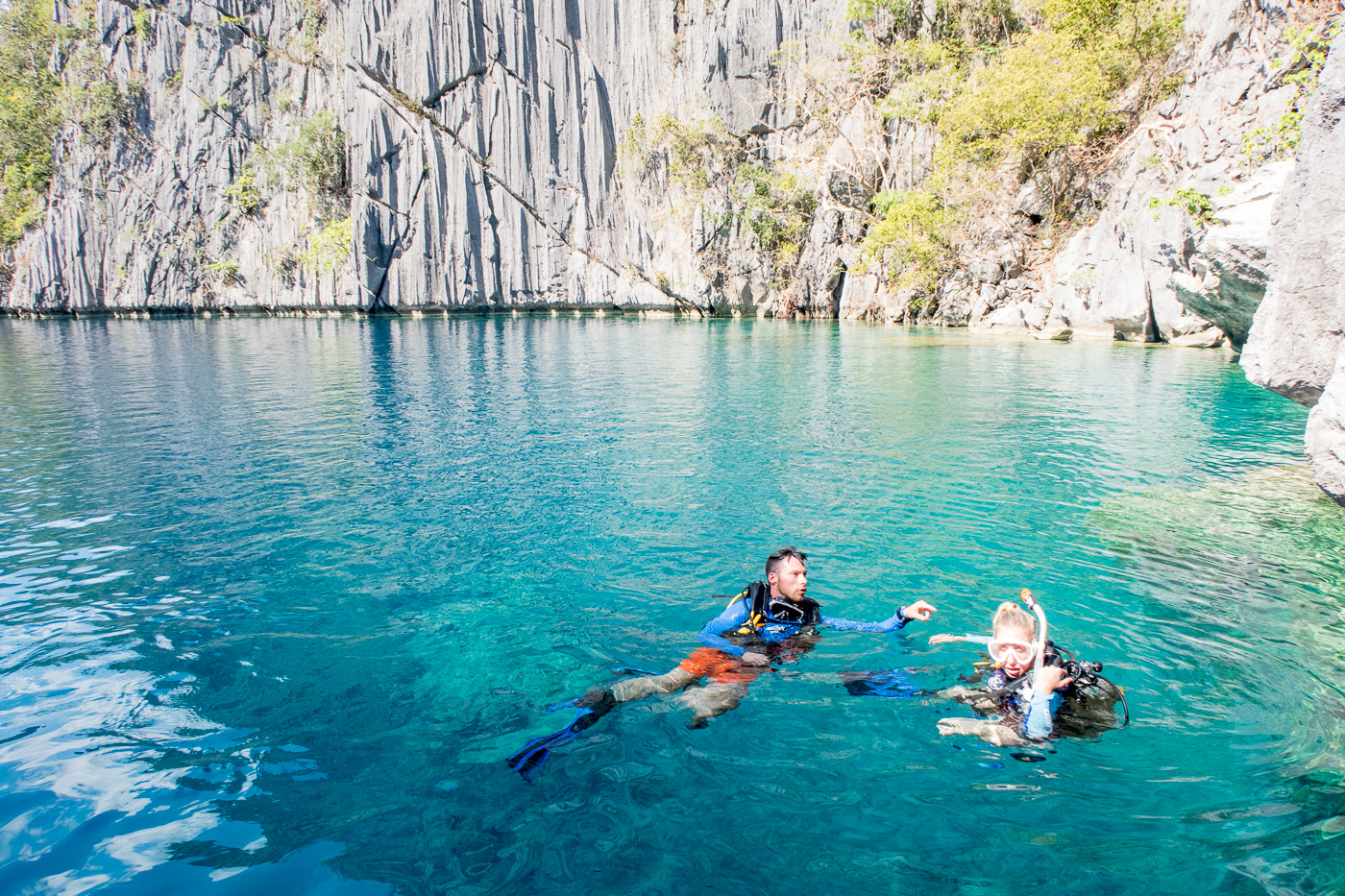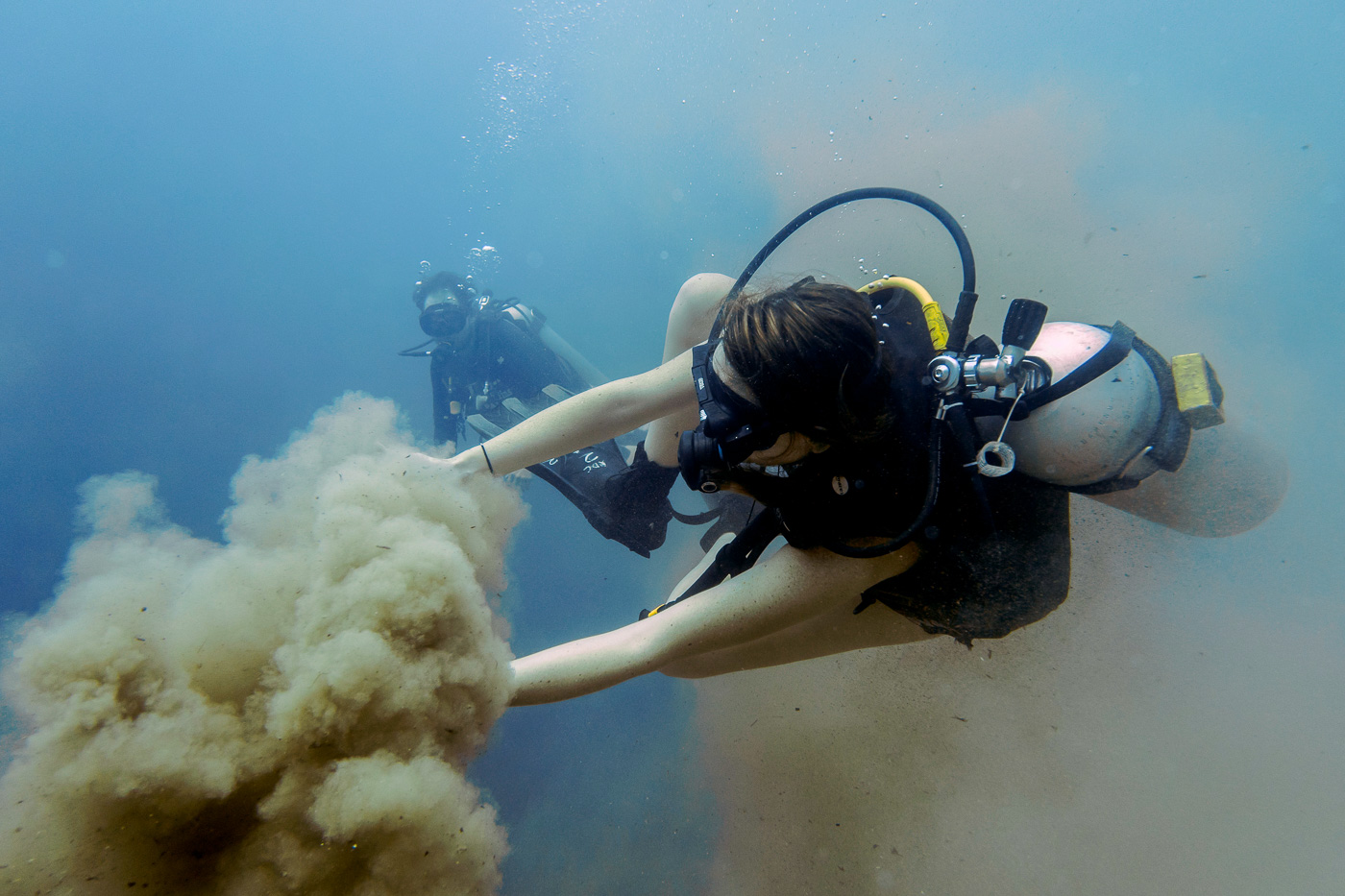Welcome to Barracuda Lake. If you are looking for one of the world’s most unique dives you have come to the right place. But unlike the macro critters of Dauin’s muck diving or the caves and caverns of Koh Haa, it is not what you see here at Barracuda Lake that will leave you enchanted; instead it is what you feel. In less than one hour, you will oscillate along a thermocline where temperatures change from 28° Celsius and 38° Celsius with the the kick of your fin, dive head first into the silty lake bottom, and have critters nibble at your fingertips. Barracuda Lake presents the curious with a unique opportunity to dive in a harmonious mix of fresh and salt water set against a backdrop of imposing jagged limestone walls. And if you are really lucky you may even have a chance encounter with the one resident barracuda for which the lake was named, who is said to lurk in the shadows of the lake’s 30 meter cave. Let’s just say, scuba diving Barracuda Lake is a sensory experience you are sure not to forget.
 Scuba Diving Barracuda Lake
Scuba Diving Barracuda Lake
At first I was so taken aback I didn’t know what was happening. Our dive master, Tim, who I was dutifully following, had just dove head first into what looked like a solid layer of mud on the lake’s bottom. He disappeared for what seemed like half a minute behind a thick cloud of dust and seashell debris, his head and shoulders completely engulfed before emerging with two hands out giving us the okay sign.
Taking our cues from him, we all proceeded in our own merriment to plunge our arms into the lake’s floor. But instead of being met with resistance, they slid in gently and easily also disappearing below. We were cautious at first then far more eager. The lake bottom was so light and airy with one throw you could fill the water with a billowing cloud of its murkiness. It was unbelievable! We played like this until the bottom was so murky we couldn’t see it anymore.
Only a few minutes prior we had passed through the lake’s most dramatic thermocline at 14 meters. Here the water temperature changes from a comfortable 28° Celsius freshwater to a shocking 38° Celsius saltwater. It is such a dramatic shift you can see the translucent boundary between the two bodies of water almost like an oily membrane separating them.
I was glad that I went with Tim’s suggestion to lose my wetsuit for the Barracuda Lake dive. The saltwater was so warm it was uncomfortable even in only a bathing suit and BCD. At first I did my best to straddle the thermocline as the sensation of having half of my body hot and the other half of my body cold was strangely peculiar. However Tim continued to lead us down, requiring us to stay within the uncomfortable heat. Just as the novelty of the extreme thermoclines was wearing off and I didn’t think I could bear the extreme temperature much longer we reached the lower layer of cool sea water giving us instant relief from our salty sweats.
The remainder of the dive we spent trolling the lake bottom. Though we found little by way of marine life, the landscape was so barren we felt like we were exploring another planet altogether. We continued along until we came to a small cave, a crack in the limestone wall, which we discovered to be the source of the heat. From here we followed the vertical rock faces back as we studied the changes in color and consistency.
Our dive ended close to the dock we jumped from. Here, as we waited out our safety stop, a set of ugly dwarf catfish and large brine shrimp nervously navigated their way to our hands and began to nibble on our skin until it was time to resurface. They were truly some of the ugliest critters we had seen under the sea. Barracuda Lake was a most unusual dive indeed!
 What Makes Coron’s Barracuda Lake So Special?
What Makes Coron’s Barracuda Lake So Special?
Barracuda Lake is foremost unique thanks to its mix of fresh water and salt water which vary so greatly in temperature from one another you won’t be able to decide whether you want to stay on the hot or cold side of the thermocline. The limestone cased lagoon was formed by a karst sink-hole which has separated the lake from the open ocean. It is volcanic activity beneath the surface that heats up the salt water trapped inside.
As you go deeper you will encounter three different thermoclines between 28° Celsius and 38° Celsius. The most surprising thermocline is at approximately 14 meters where the cooler freshwater stops and the hot saltwater starts. The change is so dramatic you can see the division line between the two types of water and swim with part of your body on one side and part of your body on the other. I’ll admit I found myself straddling the two to regulate my body temperature.
The consistency of the lake bottom is also unique starting as an almost weightless silt. Once you hit 35 meters, it turns to a jelly-like consistency. Most dive operators don’t venture this deep though as the water color also changes to a deep brown with nearly no visibility.
Finally, there is a cave at approximately 35 meters which can be penetrated by advanced divers. It is here where the alleged barracuda, for which the lake was named, is said to lurk.
 If You Go: Coron Scuba Diving at Barracuda Lake
If You Go: Coron Scuba Diving at Barracuda Lake
What: Most people associate tropical fish and whale sharks with scuba diving in the Philippines. However there is more to its vast archipelagos and islets than aqua blue seas. Barracuda Lake may be one of the most unique dives you’ll ever do, full of surprises at every turn. It was for us.
Why: Barracuda Lake is a standout thanks to its dramatic thermoclines where saltwater and freshwater oddly coexist in harmony. The first few layers of water as you dive down are normal freshwater (approximately 28° Celcius) until you approach 14 meters where you hit a halocline and thermocline and the water becomes saline and the temperature rises to a hot 39° Celcius. It is so hot you will want to skip the wetsuit. If you are an advanced diver and up for the challenge, there is also a cave at 35 meters that can be entered.
Where: Barracuda Lake is situated on the north shore of Coron island in Palawan, Philippines. It can be reached by an easy 20-minute boat ride from Coron town. If you are going with a dive operator ask to do this dive first as there are fewer tourists early in the morning and visibility is better.
When: You can dive Barracuda Lake year round.
How: Though many tourists travel to idyllic Barracuda Lake for swimming and snorkeling, the only way to experience its unique thermoclines is by scuba diving. We went with Coron dive center Rocksteady due to their stellar reviews on TripAdvisor. We combined our dive at Barracuda Lake with two additional WW2 wreck dives in Coron.
Cost: You can purchase your Barracuda Lake dive as part of a 2- or 3-dive package with Rocksteady Divers for 2,700PHP or 3,500PHP including all equipment, dive guide, entrance fees, a tasty lunch and drinks.
Disclaimer: Our Barracuda Lake dive was supported by Rocksteady Dive Center. As with everything on our blog, our opinions above are an honest account of what we experienced. As you consider your options for Coron scuba dive operators reach out to Karin at Rocksteady Dive Center (+63-(0)9288355657, rocksteadydivecenter@hotmail.com, www.rocksteadydivecenter.de).



















